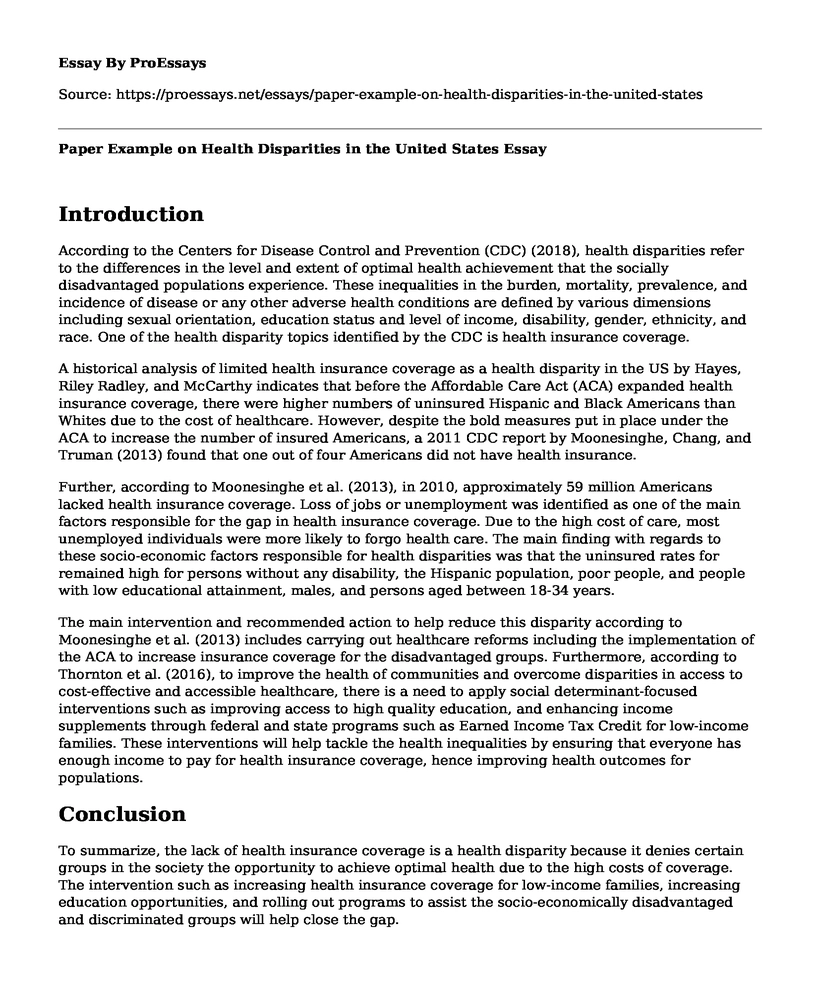Introduction
According to the Centers for Disease Control and Prevention (CDC) (2018), health disparities refer to the differences in the level and extent of optimal health achievement that the socially disadvantaged populations experience. These inequalities in the burden, mortality, prevalence, and incidence of disease or any other adverse health conditions are defined by various dimensions including sexual orientation, education status and level of income, disability, gender, ethnicity, and race. One of the health disparity topics identified by the CDC is health insurance coverage.
A historical analysis of limited health insurance coverage as a health disparity in the US by Hayes, Riley Radley, and McCarthy indicates that before the Affordable Care Act (ACA) expanded health insurance coverage, there were higher numbers of uninsured Hispanic and Black Americans than Whites due to the cost of healthcare. However, despite the bold measures put in place under the ACA to increase the number of insured Americans, a 2011 CDC report by Moonesinghe, Chang, and Truman (2013) found that one out of four Americans did not have health insurance.
Further, according to Moonesinghe et al. (2013), in 2010, approximately 59 million Americans lacked health insurance coverage. Loss of jobs or unemployment was identified as one of the main factors responsible for the gap in health insurance coverage. Due to the high cost of care, most unemployed individuals were more likely to forgo health care. The main finding with regards to these socio-economic factors responsible for health disparities was that the uninsured rates for remained high for persons without any disability, the Hispanic population, poor people, and people with low educational attainment, males, and persons aged between 18-34 years.
The main intervention and recommended action to help reduce this disparity according to Moonesinghe et al. (2013) includes carrying out healthcare reforms including the implementation of the ACA to increase insurance coverage for the disadvantaged groups. Furthermore, according to Thornton et al. (2016), to improve the health of communities and overcome disparities in access to cost-effective and accessible healthcare, there is a need to apply social determinant-focused interventions such as improving access to high quality education, and enhancing income supplements through federal and state programs such as Earned Income Tax Credit for low-income families. These interventions will help tackle the health inequalities by ensuring that everyone has enough income to pay for health insurance coverage, hence improving health outcomes for populations.
Conclusion
To summarize, the lack of health insurance coverage is a health disparity because it denies certain groups in the society the opportunity to achieve optimal health due to the high costs of coverage. The intervention such as increasing health insurance coverage for low-income families, increasing education opportunities, and rolling out programs to assist the socio-economically disadvantaged and discriminated groups will help close the gap.
References
Centers for Disease Control and Prevention. (2018). Health disparities. Retrieved from https://www.cdc.gov/healthyyouth/disparities/index.htm#1
Hayes, S.L., Riley, P. Radley, D.C., & McCarthy, D. (2015). Closing the gap: Past performance of health insurance in reducing racial and ethnic disparities in access to care could be an indication of future results. Retrieved from https://www.commonwealthfund.org/sites/default/files/documents/___media_files_publications_issue_brief_2015_mar_1805_hayes_closing_the_gap_reducing_access_disparities_ib_v2.pdf
Moonesinghe, R., Chang, M., & Truman, B.I. (2013). Health insurance coverage - United States,208-2010. Supplements, 62 (03), 61-64. Retrieved from https://www.cdc.gov/mmwr/preview/mmwrhtml/su6203a10.htm?s_cid=su6203a10_w#x2014; United States, 2008 and 2010</a>
Thornton, R.L.J., Glover, C.M., Cene, C.W., Glik, D.C., Henderson, J.A., & Williams, D.R. (2016). Evaluating strategies for reducing health disparities by addressing the socialdeterminants of health. Health Affairs (Millwood), 35(8), 1416-1423.
Cite this page
Paper Example on Health Disparities in the United States. (2022, Jul 18). Retrieved from https://proessays.net/essays/paper-example-on-health-disparities-in-the-united-states
If you are the original author of this essay and no longer wish to have it published on the ProEssays website, please click below to request its removal:
- Relationship of Primary and Secondary Sources
- Complementary and Alternative Medicine on Quality of Life of Cancer Patients - Research Paper Example
- Brain Disease and Football - Research Paper Example
- Screening and Early HIV Treatment Paper Example
- Essay Example on Reconstruction: Black Codes & the Re-Shaping of the South
- Essay Example on Migrating to a New Land: Different Perspectives
- Essay on Immunization Department Success: Research for Vaccine Discovery, Production, and Distribution







